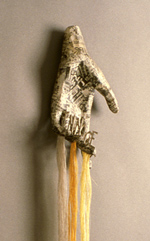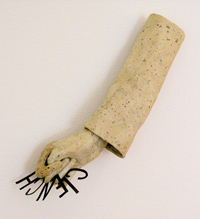Leslie Dill: Poetic Forms
BY: SIMEON HUNTER
Poem Sculptures
Arthur Roger Gallery
New Orleans, LA
Leslie Dill is known for her unusual combinations of word and image, body and text,

Innocent (Chinese), 2003, chiri paper, newspaper, thread, matte medium, 53.25 x 4.25 x 3 inches
performance and poetry. She is not alone in undertaking such investigations, but her handling of these questions is unusually skillful. The practice of mixing word and image remains something which is often done clumsily at best and which tends to be, not always unreasonably, dismissed. The graphic qualities of text and their place in the fine art world is considered by many as nothing better than an ‘impurity’, a failure of visual communication, a dubious borrowing from the demon known as graphic design, or the bastard child of an overly literary mind. Yet if we are serious about understanding the visual as a medium of communication, as a semantically rich practice which yields many meanings, then the negotiation between this sign system and the culturally dominant shorthand which uses sequenced letters to mimic speech remains a logical domain for exploration.
In this exhibition, the artist teaches doubters that verbal and visual practices may indeed be combined to forge poetic forms whose visuality remains dominant whilst evading any redundancy of the verbal within the work. Here we find a marriage of form and concept which is extraordinarily successful, a marriage of meaning and visualization in which a consistently skilled manipulation is visible at every level, where an aesthetic experience is synthesized from a variety of means into an moment of almost intolerable nicety.
Craft is no looser in this particular semantic game; there are no conceptual one liners or throw away ideas here, but rather the considered, sensitive response of an artist unafraid of making sophisticated narratives from materials which, whilst modest, celebrate at once their own beauty and the talent revealed in their precise yet nuanced manipulation,
The visual and narrative richness of each piece is belied by the apparent restraint exercised particularly with regard to color but also scale. It might seem strange to talk about economy of means in relation to such formally complex work, yet on entering the exhibition space one is disconcerted by the quiet stillness of Dill’s interventions.

Clench, 2003, chiri paper, 12 x 10 x 3 in.
The show as a whole is cream, cream and ochre, occasionally a little burnt umber for depth or emphasis. This gentle palette has two principle benefits; first, the complexity of form (combined as it always is with text) does not aggress us as otherwise it might, and second, that the organic substance of all of the materials used is discreetly underlined. The show is made of paper, silk, horse hair, underwired with just a little bronze. Just as analytical cubism restrained its palate in order to allow an audience, perplexed by extreme formal experimentation, to see what was really at stake. Dill limits me number of demands she makes on our senses to encourage the kind of attention required to really engage with the work. To borrow the artist’s own words, “leaves on trees are like a huge larynx of whisper arid possibility.”
The openness we need to hear what these materials murmur demands our acquiescence in the artist’s invitation to meditate and this invitation is made by evacuating everything extraneous from the environment she has created.
The most direct reference to this idea in the show is Voice II which is made up of an arm, modeled in three dimensions from paper, which reaches out like the branch of tree and trails paper leaves. There is a simple evocation of the relationship between the tree and the body, between the music of the wind in the leaves and the language which we so arrogantly believe belongs to us alone.
An exception to the rule, a piece made from bronze, a collection of roughly hand formed words, buried in the back of the gallery, gives us the clue to this riddle should doubt persist The text reads “He felt as if me way were opening before him to the unknown nourishment”. The straightforwardness of this statement risks the kind of flatfooted declaration too often found in conceptual work. Dill avoids this partly by casting the text in bronze, differentiating it from the majority of the work, making it a permanent declaration of intent, and then by burying the words in almost illegible, highly tactile, pinch-formed ‘writing’, whose sculptural quality is so absolutely personal that the resounding statement is softened to a muffled cry, struggling to share itself with us.
Another possible starting point for the show, and perhaps the largest individual piece, (although its dimensions are variable depending upon installation), is called Still and it makes explicit both the complex interaction of the visual and the verbal in this body of work and also the spiritual engagement which goes well beyond a romantic yearning, following rather a contemplative journey towards a subtle if not to say difficult kind of beauty.
We see an arrangement of words made in twisted wire, stepped across the top of a wall.

Arid Pleasure II, 2002, chiri paper, glue, oil paint, horsehair, wire, 25 x 12 x 5 inches
Beneath each word, a trail of pale horse hair drops almost to the ground. Because the hair is attached to the individual letters, grouped into words, and arranged in three rows, there is a consistency of texture to the drop which is reminiscent of water falling over a river’s lip, notched with boulders. Inviting us to look up and pay attention to small but important whispers, these streams return us to the source. The wall which at first appeared surprisingly resistant, gently pulls us into its textures and channels our gaze upward to the discreet text above.
The piece is astonishingly attractive at this visual level, and it is important in a textual account to try to convey the extent to which the words in the piece, which we inevitably try to read in search of access to narrative content, are at once tiny, slight and very, very clear. In spite of this typographical openness, the three row arrangement serves to deny us the immediate satisfaction which literacy too easily uses as an excuse for not reading carefully, emphasizing the castellated formal arrangement and the way in which visual practice permits the disorganization of language, leaving the viewer to reassemble narrative from fragments, the dominance of the word over the image in our culture unconsciously driving our desire for conventional forms of articulation. If we deny this impulse to re-order the word sequence and read the text rather as the visual form suggests we should, then a strongly fractured, poetic statement of doubt emerges: “faith, faith still, like half a guillotine believed as like a heavy word as light would be heavy enough”. If we follow the text line by line and ignore its castellated arrangement, its primary sequence emerges and we read: “Faith, like a guillotine, as heavy as light”.
Several of the pieces in this exhibition use hands or feet to symbolize human creativity, acts of moving and making, articulating the poetry within. Arid Pleasure, for example, includes life-sized sculptures of two hands, mounted on the wall at about shoulder height, made in natural paper, hollow, each with a broken index finger out of which horsehair pours almost to the ground. Clench represents a tightened fist, facing us, with the fingers away from the wall. Between these fingers are fanned, like a ‘hand’ of cards, the letters which form the word “clench”. Because of the three-dimensional presence of the piece, the word is redoubled in shadow-play on the wall. Innocent (Chinese) consists of a hand stretching downward, fingers curled up and out towards us, with silk strands pouring out from the cut tips of the middle to little fingers. Die-cut paper letters spelling out the word ‘innocent’ sit upright bunched almost illegibly between the curled fingers in an astonishing feat of formal play which almost defeats our desire to form the letters into text.

Head, 2003, paper, thread, muslin, steel, 6 x 7 x 3.5 inches
Head pushes this idea further, forging a smaller than life-sized human bust out of die-cut letters, producing a lace-like shell, where the natural paper letters partially overlap one another leaving little spaces through which we can see both into and through the figure, whilst at the same time allowing the careful observer to read the word ‘dancer’ repeated over and over in this semi-permeable membrane which so exquisitely negotiates the border between inside and outside, between body and identity, tacitly acknowledging the dancer’s power to negotiate complex narratives through formal dispositions of the flesh. That this act of expressive negotiation comes at a price is indicated by the faintly blue silk threads which fall from beneath the arms. The passions with which and of which the dancer tells are suggested by ivory-silk threads tumbling from the eyes to the ground. Delicate yet strong, this piece seems perhaps the most perfect in its complex weaving of narratives. A poem in its own right, composed of one word and many, many visual interventions, the overall effect is breathtaking in its aesthetic restraint.
This negotiation between surface and interior life, understood as a site of linguistic negotiation, is developed further in two subsequent pieces. First, there is a life-sized suit of clothes made entirely from overlapping letter forms which reads “I have given my voice to words” and second, in a gesture which locates the artist’s ‘voice’ in the act of making. Blue is a bas-relief wire sculpture of a dress, woven over in the most delicate, blue colored, horse hair. Where the head would be if this web contained a body, we see lines of text radiating upward, in which wire and hair are woven together to form the words “It’s a lonesome glee/yet sanctifies/the mind a spider sewed at night”.
Only rejoins these full-sized figurative pieces with the letter-lace dancer’s Head. This is

Only, 2004, bronze, paint, ink, wire, thread, 63 x 19.5 x 14.5 inches
a slightly smaller man full sized bronze male figure, painted white, whose surface is full of holes. There is a tentative, almost negligent, tape which emerges from the right foot at floor level and reads “dust is me only secret”. Here we see how close a relationship is posited between the maker-as-reader and her subjects. The invitation extended to us to contemplate calmly and hear the poetry which all life utters is an invitation which Leslie Dill has herself already accepted.
The process of expression is here revealed as first and foremost an active decision to listen. The artist has provided us with an opportunity to witness the beauty of her relationship with the words of the world; her generosity in sharing this understanding is entirely in accord with her manifest delight in representing what she herself has learned to see and hear.
TOP OF PAGE
